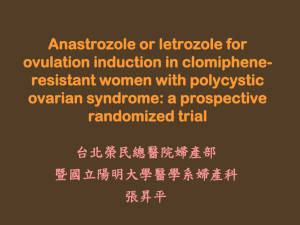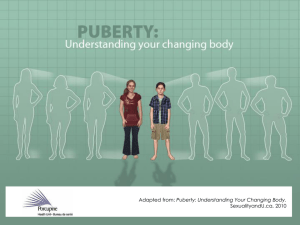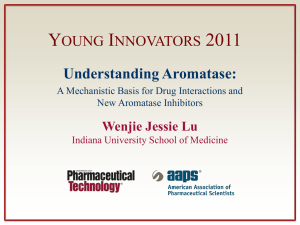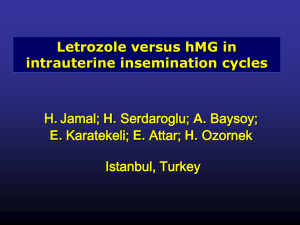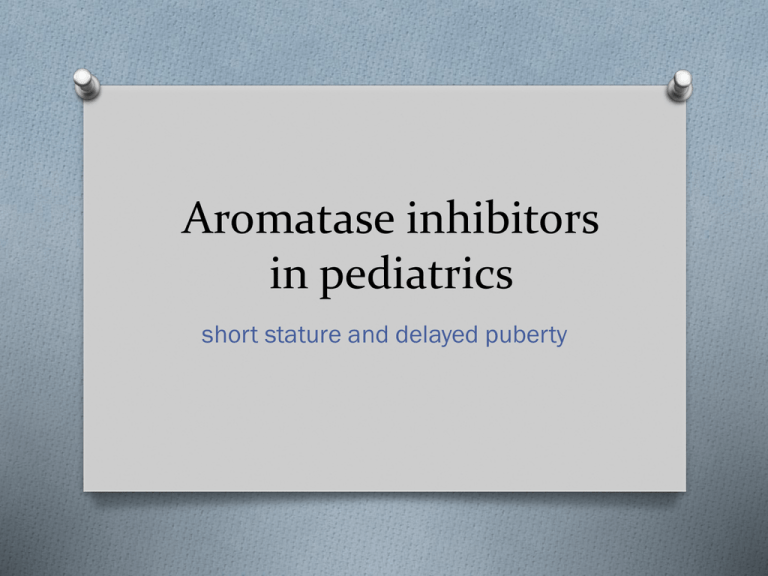
Aromatase inhibitors
in pediatrics
short stature and delayed puberty
Aromatase
O Enzyme located in the endoplasmic
reticulum of estrogen-producing cells
O Catalyzes the rate-limiting step in the
conversion of androgens to estrogens in
many tissues
Drugs
O Letrozole and Anastrozole (selective
aromatase inhibitors)
O currently approved as adjuvant therapy for
breast cancer
Aromatase inhibitors
Off-label use in pediatrics
O Hyperestrogenism (aromatase excess
O
O
O
O
O
O
O
syndrome)
Peutz–Jeghers syndrome,
McCune–Albright syndrome
Functional follicular ovarian cysts
Hyperandrogenism - testotoxicosis (also known
as familial male-limited precocious puberty)
CAH
Pubertal gynecomastia
Short stature and/or pubertal delay in boys
Physiology of aromatase
O Aromatase catalyzes the rate-limiting step
in the conversion of testosterone to estradiol
and androstenedione to estrone; estrogens
are also substrates for aromatase
O In men, most estrogen is synthesized in
peripheral tissues through local
aromatization of circulating androgens.
The principal site of aromatization is
adipose tissue (stromal cells)
O Aromatase activity can also be found
O brain (hypothalamus, limbic system and cerebral cortex)
O breast
O placenta
O liver
O muscle
O bone (osteoblasts and chondrocytes)
O testis (Leydig cells and germ cells)
O vasculature (smooth muscle cells)
O skin (fibroblasts and hair follicles)
The effect of aromatase
inhibitors on growth
O
O
O
O
O
mediated primarily via reduced estrogen
production within the epiphyseal chondrocytes,
a decrease of circulating estrogens also affects
growth hormone (GH) and insulin-like growth factor
1 (IGF-1) secretion
estrogen does not participate in the regulation of
linear growth before puberty
induces the pubertal growth spurt (at low levels)
epiphyseal maturation and closure (at high levels)
Short stature/delayed puberty
O blocking endogenous estrogen synthesis (or
bioactivity) results in retardation of bone
maturation, thereby prolonging the time for
growth and increasing adult height
Case Study
O A 14.5-year-old boy with ISS and a
O Height of 142.7 cm - SDS -2.79.
O BA 13.5-14 years,
O predicted adult height = 154 cm (SDS -
3.77)-158.2 (SDS -3.15).
5-year letrozole monotherapy
O FH was 169 cm (SDS -1.57)
O Height difference between PAH and FH from
10.8 to 15 cm.
Side effects
O No permanent side effects of the
medication have been observed.
O Both a transient occurrence and a
spontaneous recovery of decreased bone
mineral apparent density were seen, verified
DEXA.
O Spinal magnetic resonance imaging
revealed no vertebral abnormalities.
Research
O 3 trials in boys with various combinations of short
stature and delayed puberty
O
O
O
Wickman, S., Sipilä, I., Ankarberg-Lindgren, C., Norjavaara, E. & Dunkel, L. A specific
aromatase inhibitor and potential increase in adult height in boys with delayed
puberty: a randomised controlled trial. Lancet 357, 1743–1748 (2001).
Hero, M., Norjavaara, E. & Dunkel, L. Inhibition of estrogen biosynthesis with a potent
aromatase inhibitor increases predicted adult height in boys with idiopathic short
stature: a randomized controlled trial. J. Clin. Endocrinol. Metab. 90, 6396–6402
(2005).
Salehpour, S. et al. A double-blind, placebo-controlled comparison of letrozole to
oxandrolone effects upon growth and puberty of children with constitutional delay of
puberty and idiopathic short stature. Horm. Res. Paediatr. 74, 428–435 (2010)
O 1 study was done in GH-deficient boys
O
Mauras, N. et al. Anastrozole increases predicted adult height of short adolescent
males treated with growth hormone: a randomized, placebo-controlled, multicenter
trial for one to three years. J. Clin. Endocrinol. Metab. 93, 823–831 (2008).
First study
23 boys with delayed puberty (mean age 15.1
years)
O two treatment groups:
O
O 1 year of letrozole (2.5 mg once daily)
O placebo.
O Both received testosterone for 6 months and were
evaluated 18 months after initiation of therapy.
O A third group received no treatment.
Results
O PAH increased significantly more in
letrozole-treated boys than in placebotreated boys (5.1 cm versus 0.3 cm)
O The untreated controls gained
approximately 2 cm.
O Serum estradiol levels were significantly
suppressed,
O Serum testosterone, LH, FSH, and inhibin B
increased.
Follow-up study
O The adult height of the letrozole-treated
group was 6.9 cm more than the placebo
group and only 1.3 cm lower than target
height.
O In placebo-treated boys, near-adult height
was 4.8 cm below target height
Study flaws
O
almost all participants had entered into puberty at
the start of the study
O
not extremely short
O
PAH in the normal range*
O
selection bias (boys receiving letrozole tended to
be taller, have a higher PAH and taller parents than
placebo-treated controls)
Study flaws
O final analysis (the difference between the groups
with respect to PAH at the start of treatment was
larger in the 17 patients followed until near-adult
height than in the 22 patients initially included).
O
no adult height data were reported for the
untreated boys.
O
the results obtained with a combination treatment
(letrozole plus testosterone) cannot be extrapolated
to letrozole alone,
Second study
O 30 boys with idiopathic short stature (ISS)
O age 9.0–14.5
O randomly allocated to either letrozole or placebo
for 2 years
O most - prepubertal at the start
O 44% remained prepubertal after 2 years.
O height at the start <–2 SDS or >2 SD below target
height, bone age was <14 years.
Results
O similar height velocities
O bone age advanced less with letrozole
O height SDS for bone age improved by 0.7 SD,
whereas no change occurred in the placebo
group
O PAH increased by 5.9 cm
O the investigators concluded that estrogen
already plays a part in the maturation process
of the growth plate before puberty.
Changes in lumbar BMD
Follow –up
O At 6 years after the start of the study, the
difference in PAH between the letrozoletreated and placebo-treated group was not
statistically significant (166.5 cm versus
162.4 cm).
Study flaws
O prepubertal (most clinicians would be reluctant
to give aromatase inhibitors)
O frequency of vertebral deformities in this
population
O no near-adult height data are available yet
Third study
O 91 boys with constitutional delay of growth
and puberty
O randomly allocated to:
O letrozole,
O placebo
O oxandrolone
Results
O letrozole increased PAH more than placebo;
O letrozole appeared to increase height
velocity (difference in height SDS +0.5
versus 0)
O bone age advance (1.1 year per 2 years
versus 0.5 year per 2 years) was slow in
both groups.
Aromatase inhibitors cotreatment with GH
O 2 studies in the US
O Mauras, N., Welch, S., Rini, A. & Klein, K. O. An
open label 12-month pilot trial on the effects of
the aromatase inhibitor anastrozole in growth
hormone (GH)-treated GH deficient adolescent
boys. J. Pediatr. Endocrinol. Metab. 17, 1597–
1606 (2004).
O Mauras, N. et al. Anastrozole increases predicted
adult height of short adolescent males treated
with growth hormone: a randomized, placebocontrolled, multicenter trial for one to three years.
J. Clin. Endocrinol. Metab. 93, 823–831 (2008).
First study
O
open-label pilot study -20 patients treated for 1
year NO effect on PAH.
Second study
O : 52 male adolescents with GH co-treatment with
anastrozole (1 mg) or placebo for 1–3 years.
O Inclusion :
O GH deficiency and GH treatment (0.3 mg/kg per
week) for at least 6 months before the start of the
study.
O pubertal and have a residual height potential.
O 50 completed 12 months,
O 41 completed 24 months,
O 28 completed 36 months.
Population
Results:
O PAH increased in the anastrozole-treated group
(+1.3 cm, +4.5 cm and +6.7 cm after 1, 2 and 3
years, respectively),
O only 1 cm of PAH in the placebo group.
O decrease in growth velocity was greater in the
placebo group at 36 months.
Retrospective studies
O letrozole treatment for a mean duration of 1
year led to an increase of PAH of 5.5 cm,
independent of co-treatment with androgens
or GH (24 male adolescents with various
endocrine conditions who exhibited short
stature and low PAH)
O other retrospective studies in boys with
delayed puberty also reported an increased
PAH
In girls
O bone age progression appeared to decrease in one
retrospective study on the effect of aromatase
inhibitors (in combination with a GnRH analogue
O aromatase inhibition for growth enhancement in
girls with ISS is contraindicated, in view of potential
adverse effects such as virilization due to
hyperandrogenism and the development of ovarian
cysts.
In boys
O considerable evidence indicates that aromatase
inhibitors effectively delay bone maturation and
thereby increase PAH
O compared to GnRH analogues, the pubertal
development and growth spurt are less affected
O bone mass accrual as well as body composition
appear to be less affected
O near-adult height was only reported in one study
Safety
O
increased risk of vertebral deformities in
boys treated at a young age
Vertebral deformities
O ISS, letrozole treatment for 2 years during
prepuberty or early puberty - associated with
- increased risk of vertebral body deformities
compared with placebo,
O mild deformities - disturbed vertebral body
growth rather
O delayed puberty treated for 1 year during
early or midpuberty, letrozole had no effect
on vertebral morphology
References
1.
2.
3.
4.
5.
6.
7.
8.
Juul, A. et al. Serum insulin-like growth factor-I in 1030 healthy children, adolescents,
and adults: relation to age, sex, stage of puberty, testicular size, and body mass index.
J. Clin. Endocrinol. Metab. 78, 744–752 (1994)
Krebs A et al. Marked increase of final height by long-term aromatase inhibition in a boy
with idiopathic short stature. J Pediatr Endocrinol Metab. 2012;25(5-6):581-5.
Wickman, S., Sipilä, I., Ankarberg-Lindgren, C., Norjavaara, E. & Dunkel, L. A specific
aromatase inhibitor and potential increase in adult height in boys with delayed puberty:
a randomised controlled trial. Lancet 357, 1743–1748 (2001).
Hero, M., Norjavaara, E. & Dunkel, L. Inhibition of estrogen biosynthesis with a potent
aromatase inhibitor increases predicted adult height in boys with idiopathic short
stature: a randomized controlled trial. J. Clin. Endocrinol. Metab. 90, 6396–6402
(2005).
Salehpour, S. et al. A double-blind, placebo-controlled comparison of letrozole to
oxandrolone effects upon growth and puberty of children with constitutional delay of
puberty and idiopathic short stature. Horm. Res. Paediatr. 74, 428–435 (2010)
Mauras, N., Welch, S., Rini, A. & Klein, K. O. An open label 12-month pilot trial on the
effects of the aromatase inhibitor anastrozole in growth hormone (GH)-treated GH
deficient adolescent boys. J. Pediatr. Endocrinol. Metab. 17, 1597–1606 (2004).
Mauras, N. et al. Anastrozole increases predicted adult height of short adolescent
males treated with growth hormone: a randomized, placebo-controlled, multicenter trial
for one to three years. J. Clin. Endocrinol. Metab. 93, 823–831 (2008).
Hero, M., Toiviainen-Salo, S., Wickman, S., Mäkitie, O. & Dunkel, L. Vertebral
morphology in aromatase inhibitor-treated males with idiopathic short stature or
constitutional delay of puberty. J. Bone Miner. Res. 25, 1536–1543 (2010).
Thank You





